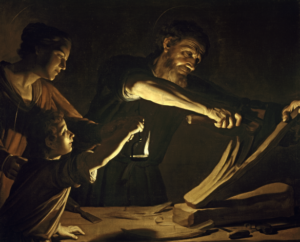Object of the Month: March 2013
The Holy Family in the Carpenter Shop
Oil on canvas
Gerrit van Honthorst
Dutch, 1592–1656
All museums have at least one or two works that visitors love to see again and again. First-time visitors often comment on their preferences after a tour through the galleries, and regular patrons tell us that they enjoy returning to see their favorite works. M&G’s Holy Family in the Carpenter Shop by Gerrit van Honthorst is one such crowd pleaser.
Honthorst’s mastery of lighting effects was inspired by the works of Caravaggio during a sojourn to Italy around 1612 or 1620. Even though Caravaggio only produced two known night paintings which depict artificial lighting such as a candle or a torch, Honthorst and a group of other Dutch artists from Utrecht followed this genre’s techniques and became known as the “Candlelight Painters.” In fact, the Italians gave Gerrit van Honthorst the nickname, Gherardo delle Notti, meaning “Gerard of the Night Scenes.”
For the viewer the primary, gripping element is the effect of light in the painting. Mary, Joseph, and Christ are gathered in a plain, dark room with a soft, warm light illuminating their forms from out of the darkness. Honthorst’s proficiency and sensitivity are noted in his ability first to concentrate the most intense light on the arms of Christ and Joseph and then subtly diffuse the beam as it stretches away from the light source. The emotional effect of the soft lighting is heightened by the characters’ gentle, loving facial expressions as well as the simple, natural portrayal of their manner. Christ holds the oil lamp while Mary carefully steadies His hand in order to position the flame for Joseph to see his work and to prevent Jesus from burning Himself.
In this favored work of M&G patrons, the meaning evoked by the light is as equally compelling as the painterly technique. Although Christ is but a child in the scene, the lamp which He grasps metaphorically alludes to the declaration of an adult Christ, “I am the light of the world: he that followeth me shall not walk in darkness, but shall have the light of life” (John 8:12). Scripture further describes Christ in these words: “In him was life; and the life was the light of men. And the light shineth in darkness; and the darkness comprehended it not” (John 1:4-5). Perhaps another layer of Biblical significance is present in the work; as the youth eagerly looks to His father to please him and help him, the act faintly implies not only a family value or work ethic of Honthorst’s time, but also a Biblical injunction to children to obey and honor their parents (Ephesians 6:1, 2).
In order to fully appreciate the impression and effect of this remarkable work, come and view the painting for yourself. You will surely come to understand why this painting has become the favorite of so many.
Published in 2013
